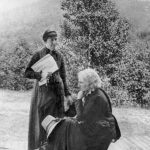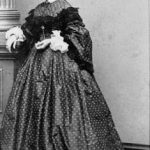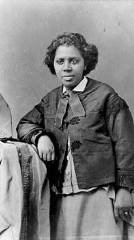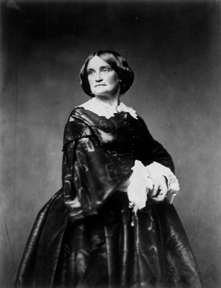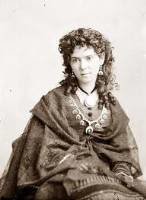One of the First Women Artists in the United States
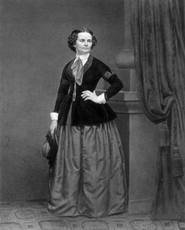 Harriet Hosmer was an American sculptor who emigrated to Rome at age 22 and became part of an expatriate community of American writers and artists, including a circle of prominent independent women. Hosmer was celebrated as one of our country’s most respected artists, and is credited with opening the field of sculpture to women. She worked primarily in marble, and the quality of her surviving work is extraordinary.
Harriet Hosmer was an American sculptor who emigrated to Rome at age 22 and became part of an expatriate community of American writers and artists, including a circle of prominent independent women. Hosmer was celebrated as one of our country’s most respected artists, and is credited with opening the field of sculpture to women. She worked primarily in marble, and the quality of her surviving work is extraordinary.
Hosmer brought honor to both her country and her gender, proving that Americans can be sculptors and that a woman can handle a chisel as well as a palette and a brush. Her work was celebrated and drew thousands to galleries across the country. Much of her work has been lost or destroyed, preserved in sketches and descriptions but otherwise forgotten.
Early Years
Harriet Hosmer was born on October 9, 1830 at Watertown, Massachusetts. Her mother, Sarah Grant Hosmer, as well as her sister and two infant brothers, died before Harriet turned twelve. In response, her father Hiram Hosmer, a prominent physician, pulled his only remaining child out of school and implemented an exercise regimen that took Harriet far afield of the domestic sphere that was then considered a woman’s destiny.
Harriet soon became an all around athlete – hunting, fishing, horseback riding and hiking around her Massachusetts home, and swimming and rowing in the Charles River. In the fields and forests she also gained a thorough knowledge of animal life. While she was still a child she began to model dogs, horses and other animals in a clay pit near her home, and soon found that sculpting was her forte.
Hiram Hosmer then sent his daughter to the Sedgewick School in Lenox, Massachusetts, where she not only received a rigorous education but developed lifelong friendships that would serve her well both personally and professionally. Sedgwick was a progressive school that fostered independence and provided Hosmer with creative women role models, like novelist Catharine Maria Sedgwick and actress Fanny Kemble.
After graduating in 1849, Harriet Hosmer established a studio at home and made what progress she could on her own. She studied briefly with Boston sculptor Peter Stephenson but was soon frustrated by her inability to study anatomy, since she was excluded from the all-male medical classes.
In autumn 1850 Hosmer traveled to St. Louis to visit Cornelia Crow, her friend from the Sedgwick School and daughter of the future founder of Washington University, Wayman Crow. Hosmer lived with the Crow family while furthering her knowledge of anatomy by taking private lessons at the Missouri Medical College.
In summer 1851 Hosmer returned to Watertown after receiving an anatomy certification, making her the first woman to study at what later became the Washington University School of Medicine. At work in her home studio, Hosmer completed a medallion as a gift for Dr. McDowell of the Missouri Medical College.
Other works completed during this time period include a bust of Napoleon for her father and the idealized bust of Hesper (mythological maiden of the Evening Star) (1852), her first original work, which was inspired by the imagery in Tennyson’s poem In Memoriam.
Hosmer had no patience for the strict rules of decorum that regulated the behavior of young ladies in the polite circles of her day. Instead, she worked long hours in the studio, perfecting her art. One of Hosmer’s early sculptures caught the eye of Charlotte Cushman, one of the most famous American actresses of her day. Cushman was particularly admired for playing men’s parts, a popular practice in nineteenth-century theater.
Life in Rome
Charlotte Cushman was preparing to retire from the stage and live in Rome, and she took Hosmer, aged 22, with her. There Hosmer shared a house with Cushman, novelist and journalist Matilda Hays and Sara Jane Clark (pen name Grace Greenwood). The artist entered Cushman’s inner circle, and became one of her household of ‘jolly bachelor women.’
Shortly after Hosmer’s arrival, she persuaded British artist John Gibson – the leading neoclassical sculptor at that time – to train her as his pupil. Working in his studio, she immediately began copying masterpieces in order to develop her skill. From 1853 to 1860 she apprenticed with Gibson, and very quickly hung out her own shingle.
Hosmer was not the only female sculptor in Rome at this time, however; she became one of a group that were dubbed “that strange sisterhood of American lady sculptors who at one time settled upon the seven hills [of Rome] in a white marmorean (resembling marble) flock” by American author Henry James. These included Anne Whitney, Emma Stebbins, Edmonia Lewis and Vinnie Ream.
Hosmer quickly became a key figure among a large international circle of artists and writers living in Rome that included poets Robert and Elizabeth Barrett Browning, William Wetmore Story, William Makepeace Thackeray and George Eliot. This creative, exciting world was further spiced by parties, theatricals and balls. Henry James described Hosmer as the “life of every party.”
But all was not bliss in Cushman’s ‘jolly’ household. There was no doubt about the relationship between Cushman and Matilda Hays. Elizabeth Barrett Browning noted, “I understand that [Cushman] and Miss Hays have made vows of celibacy and of eternal attachment to each other – they live together, dress alike… it is a female marriage.”
Such relationships were common between women in the nineteenth century and were accepted, in part because women were believed to be passionless. In 1854, Matilda Hays left Cushman for Harriet Hosmer. It did not last (Hays went back to Cushman until a final break up in 1857).
Although she had relationships with women, Hosmer was well-aware that her livelihood depended on maintaining an image that did not challenge the era’s gender roles outright. Nonetheless, she managed to comment on the condition of women and the debate about slavery through her work. Daphne and Medusa, both completed in 1854, challenged popular representations of these mythological figures, emphasizing their humanity.
Hosmer had many relationships with women throughout her life, but she seems to have been most devoted to Louisa, Lady Ashburton, a widowed Scottish noblewoman. They were together for 25 years. Hosmer called Ashburton her “sposa” and risked her long friendship with Robert Browning when he and Ashburton had a public falling out.
Both Ashburton and Hosmer may have been too volatile to live a life of quiet domesticity; but they did have many happy years together as a couple. The two shared finances and wrote intimate letters in which Hosmer called herself both “hubbie” and “wedded wife.” In many letters, she spoke of her devotion and also jealousy at the thought of being replaced by another woman.
Hosmer faced derision from her male counterparts and from those who disapproved of her masculine dress and deportment. Known as an ’emancipated female’ for her radical behavior of living alone, walking alone, and riding horseback alone, Hosmer soon gained a reputation not only as a talented sculptor but also as a pioneering advocate for women’s rights.
Career in Art
Hosmer was a figurative sculptor in marble, and most of her pieces depict ill-fated heroines drawn from mythology and romantic literature. Her preference for female subjects is a reflection of her concern for the secondary status of women in the nineteenth century. In 1853 she completed Daphne, her first original work in Rome. She made two copies: one for public display in Gibson’s studio, the other for the Crow family in St. Louis.
In 1854 she completed Medusa, which captures the mythological Medusa at the moment of her transformation from a lovely mortal into a gorgon – a snake-haired monster whose look turned men to stone. By portraying Medusa as still beautiful rather than hideous, Hosmer emphasizes the complex dual nature of this legendary figure. It would later be sent to Boston for exhibition, after which it would become the property of Samuel Appleton.
Her next sculpture, an amusing figure of Puck (1855), brought her the most money and fame of all her works. Fifty copies were sold for $1,000 each, including one to the Prince of Wales (later Edward VIII). In 1856 she delivered her first commissioned piece, Oenone (1855), to Wayman Crow. This is her first full-length, life-size figure. She developed the idea for this work after reading Alfred Lord Tennyson’s poem Oenone.
Her second commissioned work, Beatrice Cenci (1857), went to the St. Louis Mercantile Library. Beatrice Cenci was based on the story of a young Italian heroine from the Middle Ages who was executed for planning the murder of her abusive father. After the murder was carried out, Beatrice, her stepmother and younger brother quietly disposed of the body of the man who had brutalized the son physically and had abused both the women physically and sexually.
In spring 1858 Nathaniel Hawthorne met Hosmer at Gibson’s studio in Rome. Thereafter, Nathaniel and Sophia Hawthorne visited Hosmer frequently. It is believed that she was the model for Hilda in Hawthorne’s novel The Marble Faun. Other references to Hosmer or characters inspired by her appear in the writings of Louisa May Alcott and Kate Field among others.
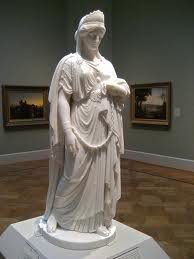 Image: Zenobia in Chains by Harriet Hosmer
Image: Zenobia in Chains by Harriet Hosmer
The Huntington paid 192,500 British pounds – roughly $385,000 – for the sculpture which is considered Harriet Hosmer’s masterpiece: Zenobia in Chains (1859), a seven-foot marble statue. Zenobia was a third century queen taken prisoner by the Roman emperor Aurelian and marched through the streets in chains.
In contrast to typical mid-19th century classical sculptures of captive women – naked, in shackles and with downcast eyes – Hosmer’s Zenobia is dignified, fully dressed and holding the chains in her hand. Hosmer used this work to comment on the potential – and fear of – female power. It was a bold statement for any woman artist of the time to make.
While many Neoclassical artists depicted mythological figures, Hosmer was chiefly drawn to female characters whose stories could be viewed as allegories for her strongly held feminist beliefs. Her Zenobia in Chains can easily be compared to the condition of 19th-century women, who were placed on a pedestal but simultaneously enslaved by harsh financial constraints that made them dependent upon men.
I honor every woman who has strength enough to step out of the beaten path when she feels that her walk lies in another.
When Hosmer produced the towering Zenobia in 1859, the work was met with disbelief that a woman created it. John Murdoch, Director of the Huntington Art Collections states:
Zenobia is one of the most famous – and controversial – objects produced during the ‘golden age’ of American classical sculpture. Some critics at the time questioned whether a work of such sublime expression, on such a scale, and requiring such power of hand and arm in the carving, could have been done by a woman.
Hosmer defied the commonly held idea that sculpture was physically beyond a woman’s capabilities. In response to an 1862 article in the Art Journal suggesting her work was done by skilled male assistants, she wrote “The Process of Sculpture” for Atlantic Monthly, explaining the sculptural process step-by-step in an effort to refute rumors that others did her work for her.
In summer 1864 she took her sculpture Zenobia in Chains to New York for exhibition, where it was purchased by New Yorker Almon Griswold. Hosmer left for Rome on November 16, 1864, after which Zenobia opened at Childs and Jenks Gallery in Boston with record-breaking attendance.
In 1865 her Sleeping Faun was purchased by Sir Benjamin Guinness for the city of Dublin for $5,000. Other notable works by Hosmer from this period include Waking Faun, Browning Hands, Death of the Dryads, Siren Fountain and Heroine of Gaeta, a figure of the queen of Naples that was unveiled in 1871.
Considered the foremost woman sculptor of her time, Hosmer portrayed the image of a strong woman, unbowed, even when crushed under patriarchal power. Of the leading female sculptors working in Rome in the 19th century, she was perhaps the only one to gain complete financial independence through her artistic work.
Her talent and independent spirit propelled a long, successful career. She was known for her eccentric, practical style, her man-tailored jackets and short hair. She maintained a large studio and enjoyed a considerable income from her work. Her position as the foremost American female sculptor was unchallenged during her lifetime
After the Civil War, however, the shift in American taste away from Neoclassical art made it more difficult for Hosmer to make a living as a sculptor. Beginning in the 1870s she devoted a large portion of her time to developing a perpetual motion machine and artificial marble. She also devised a process of modeling in which the rough shape of a statue is first made in plaster, on which a coating of wax is laid for working out the finer forms.
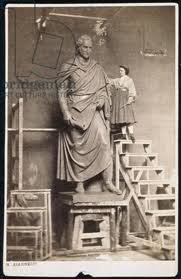 Image: Hosmer working on her Thomas Hart Benton Statue
Image: Hosmer working on her Thomas Hart Benton Statue
In 1860 Harriet was commissioned by the state of Missouri to produce this monumental bronze statue of Senator Thomas Hart Benton. The bronze statue was unveiled in Lafayette Park in St. Louis on May 27, 1868.
An ambitious, single woman Hosmer became increasingly interested in women’s rights, eventually befriending Susan B. Anthony and working with the Chicago suffragist group, the Queen Isabella Society. In 1893 the Society commissioned Hosmer to sculpt Isabella of Castille, her last major work, which was exhibited at the World’s Columbian Exposition in Chicago.
She returned to the United States permanently in the 1890s, living in Chicago and Terre Haute, Indiana. She devoted a large part of her time trying to invent a perpetual motion machine and artificial marble. From roughly 1900 on, she lived in her hometown of Watertown, Massachusetts.
Harriet Hosmer died at Watertown on February 21, 1908 at age 77.
SOURCES
Harriet Goodhue Hosmer
Wikipedia: Harriet Hosmer
Feminists for Choice: Harriet Hosmer
